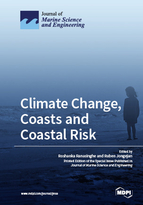Climate Change, Coasts and Coastal Risk
A special issue of Journal of Marine Science and Engineering (ISSN 2077-1312).
Deadline for manuscript submissions: closed (31 May 2018) | Viewed by 89765
Special Issue Editors
2. Water Engineering and Management, University of Twente, P.O. Box 217, 7500 AE Enschede, The Netherlands
Interests: coastal engineering; morphodynamic modelling; coastal erosion; climate change; coastal risk
Special Issues, Collections and Topics in MDPI journals
Special Issue Information
Dear Colleagues,
Projected climate change driven variations in mean sea level (i.e., Sea level rise), wave conditions, storm surge, and riverflow will affect the coastal zone in many ways. On the other hand, the coastal zone is the most heavily populated and developed land zone in the world with rapid expansions in settlements, urbanization, infrastructure, economic activities and tourism.
The combination of coastal climate change impacts and their effect on the ever increasing human utilization of the coastal zone will invariably result in increasing coastal risk in the coming decades. However, while the economic damage (potential consequence) that can be caused by CC driven coastal inundation and erosion (potential hazard) is likely to increase, foregoing land-use opportunities in coastal regions is also costly (opportunity cost). Thus, a ‘zero risk’-policy could have severe economic consequences, while high risk policies could lead to risks that are unacceptable to society and individuals. Developing appropriate policies and strategies for land-use planning purposes is, therefore, a delicate balancing act.
To avoid unacceptable future risks, due to coastal hazards and/or sub-optimal land use, it is imperative that risk informed and sustainable coastal planning/management strategies are implemented sooner rather than later. This requires comprehensive coastal risk assessments which combine state-of-the-art consequence (or damage) modelling and coastal hazard modelling. Apart from being of crucial importance to coastal managers/planners, this type of risk quantification will also be invaluable to the insurance and re-insurance industries for insurance pricing, which may have a follow-on effect on coastal property values. However, the present level of knowledge on generally applicable coastal hazard and risk assessment approaches, especially at local scale (~10 km) is rather limited. To help bridge this knowledge gap, this Special Issue invites original scientific contributions focusing on:
- Projections of climate change driven variations in coastal forcing (SLR, storm surge, waves)
- Assessment of climate change driven physical impacts on coasts
- Quantifying economic and/or environmental risk in coastal zones
Research articles, review articles, case studies and perspectives are welcome to this Special Issue. We look forward to receiving original and inspiring contributions.
Prof. Roshanka Ranasinghe
Dr. Ruben Jongejan
Guest Editors
Manuscript Submission Information
Manuscripts should be submitted online at www.mdpi.com by registering and logging in to this website. Once you are registered, click here to go to the submission form. Manuscripts can be submitted until the deadline. All submissions that pass pre-check are peer-reviewed. Accepted papers will be published continuously in the journal (as soon as accepted) and will be listed together on the special issue website. Research articles, review articles as well as short communications are invited. For planned papers, a title and short abstract (about 100 words) can be sent to the Editorial Office for announcement on this website.
Submitted manuscripts should not have been published previously, nor be under consideration for publication elsewhere (except conference proceedings papers). All manuscripts are thoroughly refereed through a single-blind peer-review process. A guide for authors and other relevant information for submission of manuscripts is available on the Instructions for Authors page. Journal of Marine Science and Engineering is an international peer-reviewed open access monthly journal published by MDPI.
Please visit the Instructions for Authors page before submitting a manuscript. The Article Processing Charge (APC) for publication in this open access journal is 2600 CHF (Swiss Francs). Submitted papers should be well formatted and use good English. Authors may use MDPI's English editing service prior to publication or during author revisions.







